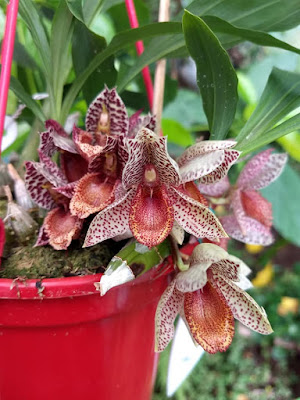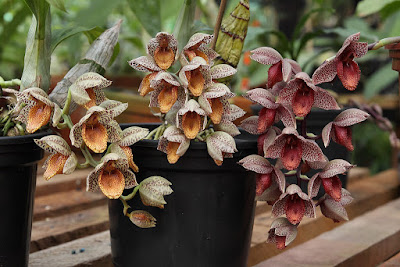Catasetum denticulatum is found in Brazil, southern Rondônia State, municipality of Ji-Paraná. It grows on a dead tree on high ground in a forest at elevations of 100 to 300 meters above sea level.
Catasetum denticulatum also called as The Small-Toothed Catasetum, is a species of the genus Catasetum. This species was described by Francisco E.L.de Miranda in 1986.
IDENTIFY CATASETUM DENTICULATUM ORCHID PLANT
Catasetum denticulatum is found in Brazil, southern Rondônia State, municipality of Ji-Paraná. It grows on a dead tree on high ground in a forest at elevations of 100 to 300 meters above sea level.
It is a medium sized, hot growing epiphyte with clustered fusiform, 17 cm long and 4 cm wide pseudobulbs that are enveloped basally by several deciduous leaf sheaths and carries 5 to 10, plicate, arched, oblanceolate, 25 cm long and 4.3 cm wide leaves.
The Small-Toothed Catasetum blooms in the late spring and early summer on a basal, erect to suberect, several flowered, racemose inflorescence arising basally on a new pseudobulb lead. The male flowers are 4 cm in diameter with coloration of sepals rose, spotted with dark red; petals the same color with fewer but larger blotches of dark red; lip orange-rose, with fine dark red spotting; antennae pale rose. The female flowers are not seen.
The margins and the form of the lip are the most important features distinguishing this species from 2 related ones: Catasetum cirrhaeoides and Catasetum pulchrum. All 3 members of the group feature clustered flowers on pendent inflorescences, but the lips of Catasetum denticulatum flowers are concave and not pouched as those of Catasetum cirrhaeoides and Catasetum pulchrum are, and its lip margins are serrated while those of the others generally are not.
CATASETUM DENTICULATUM ORCHID PLANT CARE AND CULTURE
Cultural information should only be used as a guide, and should be to be adapted to suit you. Your physical location; where you grow your plants, how much time you have to devote to their care, and many other factors, will need to be taken into account. Only then can you decide on the cultural methods that best suit you and your plants.
Light:
Catasetum denticulatum are sun-loving plant and needs a light level of 30000-60000 lux. Unless the strong air movement found in the natural habitat can be duplicated, however, the grower should provide some shade (40 % shade). This species can be grown under lights if sufficient light intensity can be provided, and the plant certainly can be summered outdoors if their moisture requirements can be met.
Temperature:
In their natural habitat, the climate is evenly hot, moist, and tropical. This climate is almost the same year-round, with high humidity at night, even in the dry season, which is relatively short. The nighttime temperatures rarely fall below 18°C, with daytime highs generally from 29 to 35°C. The important thing is to maintain evenly warm conditions, and for this orchid the closer the night minimum is to 21°C, the better the plants will respond.
Humidity:
The Small-Toothed Catasetum tolerate an environment with 40 - 60 % relative humidity during their growing season, but for optimal development of new growth and flowering, 70 % is recommended.
Substrate, growing media and repotting:
Catasetum denticulatum can be grown in pot, container or wooden basket with fir bark, osmunda, tree fern fiber, charcoal, and sphagnum, in various proportions or combined with still other ingredients such as sponge rock, perlite, leaf mold, peat, and bark screenings as substrate.
It is recommended to repot every year and never wait more than two years. The optimal time for potting or repotting is when new growth on a plant emerging from dormancy is about 5 cm tall and the nubs have developed into new roots that are reaching for support.
Watering:
In its natural habitat it receives rainfall frequently even while dormant. Mounted, basket-grown, and unconventionally potted plant may be watered every sunny day during the growing season, provided conditions are such that they dry off relatively quickly. In the case of conventionally potted adult plants, it should not be necessary to water more than once or, at most, twice a week. This species like to dry out at least slightly between waterings.
Fertilizer:
Fertilize with an appropriate formulation at least every week during the growing season, or fertilize with a weak formula every time the plants are watered. It is important to begin regular applications of high-nitrogen fertilizer (such as 10-5-5) with a full range of trace elements. As the leaves begin to unfurl, and well before flowering, add a high-phosphorus formula to develop big, strong pseudobulbs capable of producing robust inflorescences. Any of the soluble products with a large second-digit number (for example, 3-12-6) constitute a good source of phosphorus.
Rest period:
When the Catasetum denticulatum plants are leafless and no new growths are visible, the grower must respect their state of dormancy. Watering frequency should be reduced during dormancy. Fertilization should stop completely during this period. In the springtime, at the beginning of the growth cycle, water should not be made regularly available for the newly developing roots until the new growth is at least 5 cm tall.















COMMENTS